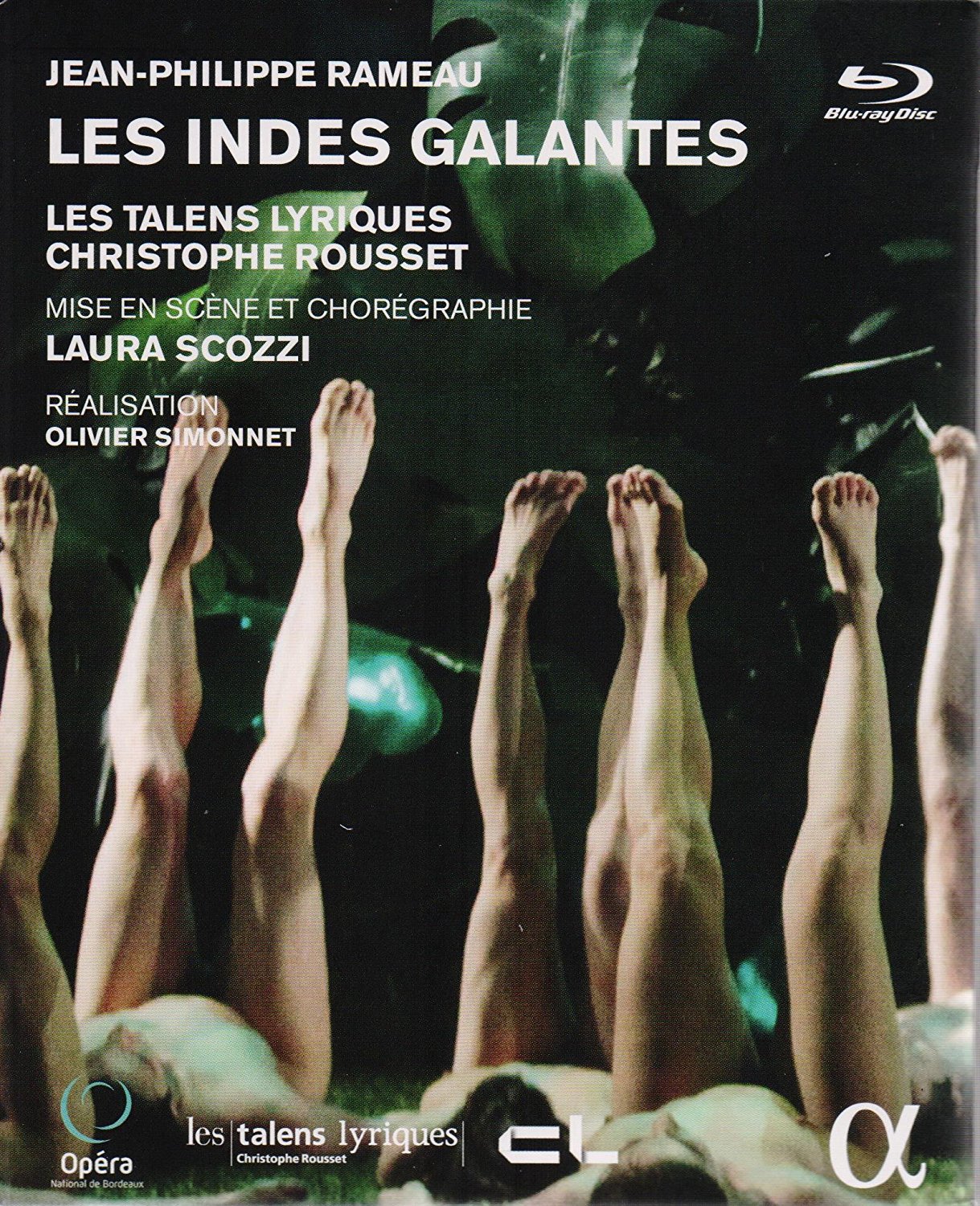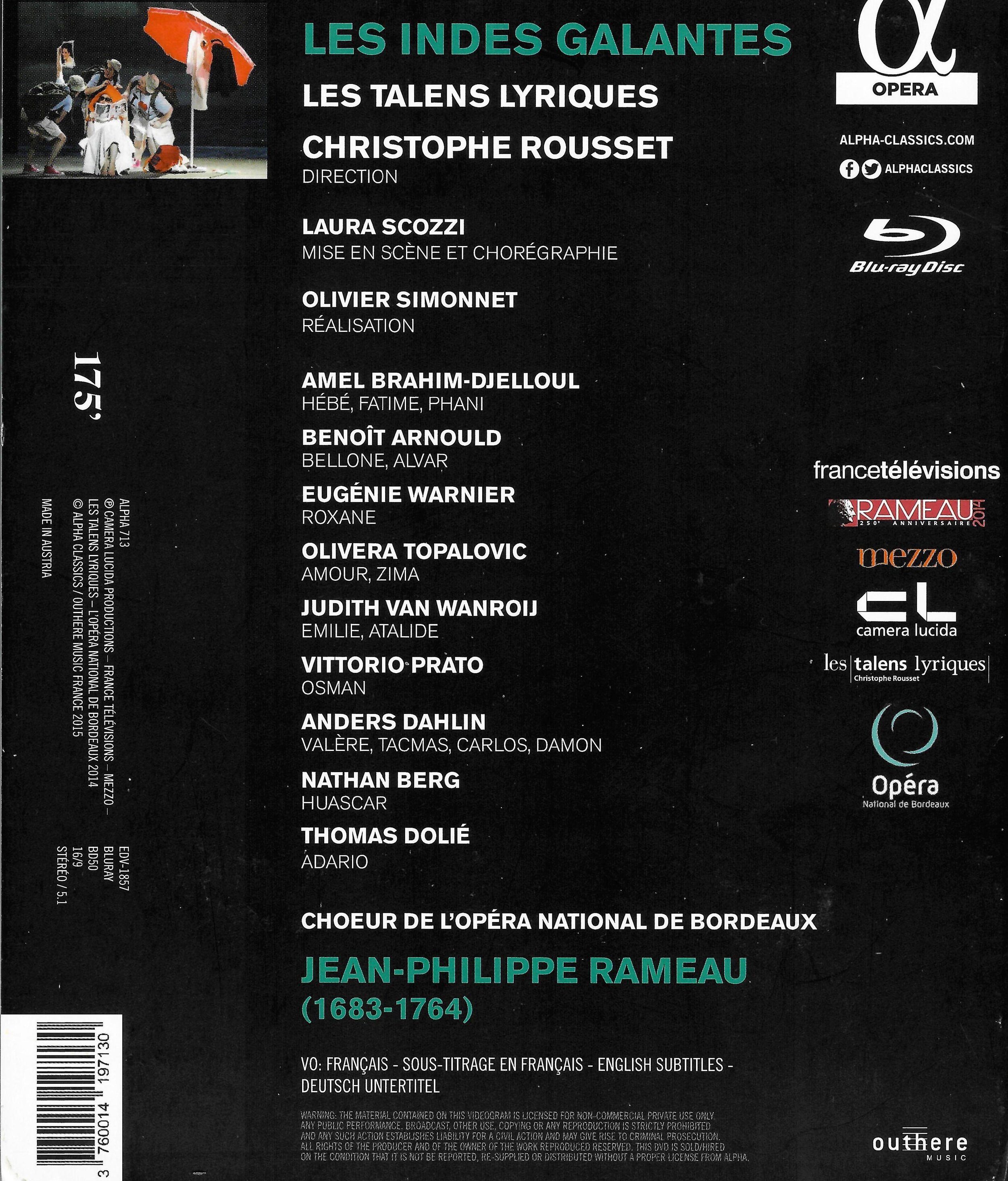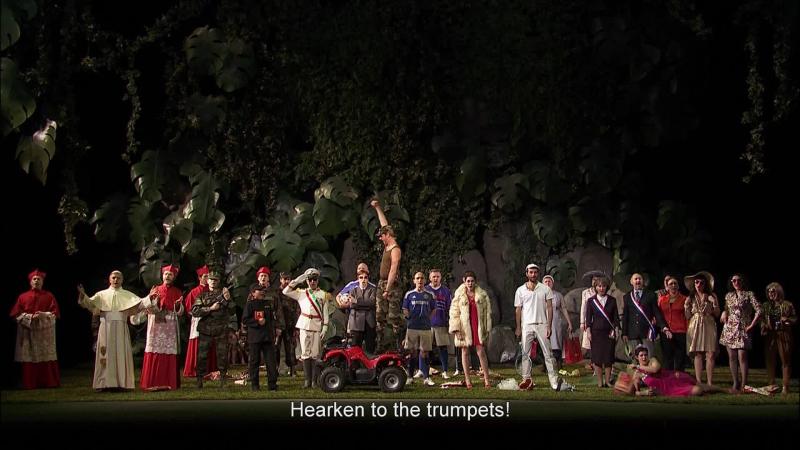

Jean-Philippe Rameau Les Indes galantes opera-ballet to a libretto by Louis Fuzelier. Choreographed and directed 2014 by Laura Scozzi at the Bordeaux National Opera. Stars Amel Brahim-Djelloul (Hébé/Fatime/Phani), Benoît Arnould (Bellone/Alvar), Eugénie Warnier (Roxane), Olivera Topalovic (Amour/Zima), Judith van Wanroij (Emilie/Atalide), Vittorio Prato (Osman), Anders Dahlin (Valère/Tacmas/Carlos/Damon), Nathan Berg (Huascar), and Thomas Dolié (Adario). Christophe Rousset conducts Les Talens Lyriques and the Choeur de L'Opéra National be Bordeaux (Chorus Director Alexander Martin). Sets by Natascha Leguen de Kerneizon; costumes by Jean-Jacques Delmotte; lighting by Ludovic Bouaud. Directed for TV by Olivier Simonnet; produced by Jean-Stéphane Michaux. The publisher Alpha-Classics is a French company, and the keepcase material is in French. Sung in French. Released 2015, disc has 5.1 dts-HD Master Audio sound. Grade: A with ‽ designation for extensive nudity.
Jean-Philippe Rameau's first hit was the opera Hippolyte et Aricie from 1733. In 1735, Les Indes galantes (The Amorous Indies) was his first opera-ballet. It's a package of 5 mini-operas: a prologue followed by 4 independent pieces, each running from roughly 30 to 40 minutes. The Prologue is set in a mythological garden (here the Garden of Eden). Bellone, the God of War, enters the Garden and leads the men off to the joy of combat. Amour then sends the women off to observe 4 stories about love; director Scozzi assigns this task to 3 lady comedians called the “love tourists.” I'll name the love stories in English: (1) The Generous Turk, (2) The Incas of Peru, (3) The Flowers of Persia, and (4) The Savages of North America. The folks you see in the Garden are dancers or extras. The protagonists in the love stories are opera singers supported by chorus folk and extras.
When I first saw and reviewed this, I didn’t know what to think of the nude dancing and Scozzi’s caustic treatment of the “Persian” men with their savage attitude towards women, which could even be seen as Islamophobic. I originally gave this a C grade, but now I think the correct grade in an A with the ‽ designation. Scozzi, her team, and the Bordeaux management came but here with an extraordinarily apt, clever, funny, thought-provoking, and totally fearless recreation of Rameau’s opera-ballet.
Most of the dancing is in the Garden of Eden. The people with their legs in the air on the keepcase cover art are dancers. I didn't observe myself just from the cover art is that the dancers are nude. Our first screen shot shows this complete scene with 11 dancers in all their naked glory:
Rameau has been resting in peace for a long time. But the performance of his prologue in the nude maybe jarred him awake. Nothing in the rest of this show is, of course, historically correct (or politically correct either). I think the original words and music are substantially preserved in each story, but director and choreographer Laura Scozzi radically updated the mise-en-scène and plot elements to be socially beneficial in today’s world. The next shot is from The Generous Turk with Osman, a trafficker in people (Vittorio Prato), his captive Emilie (Judith van Wanroij), and Valèrie (Anders Dahlin), in love with Emilie. This looks like a thriller, but doesn't end up that way:
Here's a shot from The Incas of Peru with drug lord Huascar (Nathan Berg) trying (in his own way) to make love to Phani (Amel Brahim-Djelloul):
Next below are some of the Flowers of Persia. I can't be sure, but I think the Flowers are portrayed by 6 extras or "figurants": Laure Cohen, Faustine Lasnier, Rachel Armand, Mathilde Bonicel, Pauline Buenerd, and Chloé Leruth:
The next two screen shots are from the 4th story, The Savages of North America. The conservationists (Indians in the original) have lost their legal and publicity battles to preserve the pristine beauty of this lake in the California redwood forest. The winners are the developers and consumers (European settlers in the original) who lust for housing subdivisions and fast-food palaces:
These 3 cupids (Daphné Mauger, Cécile Theil-Mourad, and Laetitia Viallet, are the love tourists who make themselves obnoxious in all 4 love stories:
Now that you've seen a bit about each of the 4 mini-operas, here's more about the nude Prologue. Neither Laura Scozzi nor the dancers are afraid of full-frontal exposure. The 11 dancers (5 men and 6 women) are Salomé Curco-Llovera, Claire Laureau, Charlie Merlet, Maud Payen, Carole Bordes, Muriel Turpin, Victor Duclos, Olivier Sferlazza, Rodolphe Viaud, Grégory Alliot, and Guillaume Emeric:
30 minutes is a long time to dance in the buff; Scozzi comes up with many variations:
Hébé, the Goddess of Youth, is sung by Amel Brahim-Djelloul. Being immortal (and a singer rather than a dancer), she gets a diaphanous costume:
Nude choreography gets boring fast. Things tend to happen fast in a blur of wiggle, jiggle, and giggle. Many dance steps that are routine when dressed become problematical for the nude dancers and the audience. So you wind up with goofy positions like this where a certain distance is maintained between the partners that you just don't think about normally:
Bellone, the God of War (Benoît Arnould), supported by many pillars of society, enters the Garden and entices the men to leave for martial art training:
The women are devastated. To cheer them up, Amour sends the women, represented now by the love tourists, to the Indies for lesson in love. (The word "Indies" used to mean any exotic place):
Now we return to the 1st love story, The Generous Turk. We are on a beach in Turkey, where Osman is keeping his beautiful European woman captive while he traffics and smuggles people. The love tourists are astonished to see how different things are from the Garden of Eden:
In the original, Rameau's story was similar to the story told by Mozart in his Entführung aus dem Serail. So here we see Osman releasing his Europeans:
But Scozzi uses the power of love to provide a surprise ending:
Next we look a bit more at the 2nd story, The Incas of Peru. In the original, the Inca Princess Phani is in love with the conquistador Don Carlos. Huascar, the Priest of the Volcano, is also in love with Phani and is willing to end the world rather than lose her. In the next screenshot, Phani sings a famous song to Hymen while in the embrace of Don Carlos (Anders Dahlin):
But Phani is already enchained to the High Priest, who commands all of Peru's new goldt:
And possesses any woman he wants:
But eventually, Huascar is attacked by a superior force (can’t tell for sure if it’s the Drug Enforcement Agency or a rival gang). Huascar brings destruction down on himself:
(No opera house in Boudeaux was burned down during this production.)
Now we return to the 3rd story, The Flowers of Persia. Here there is vast confusion caused by the publisher Alpha-Classics. Rameau had a "First Version" of Flowers, and that version is described in the synopsis in the keepcase booklet. Later Rameau wrote a completely different "Revised Version" of Flowers, and that's what Scozzi used in her show. To tell for sure which singers and roles are in the film, you have go to the credits in the film itself—this information is not given in the keepcase booklet. [So if you watch this disc, here's a friendly guide: Tacmas, the master, is played by Anders Dahlin. His wife is Fatime, played by Amel Brahim-Djelloul, who is dressed as a man. Fatime thinks that her rival is Atalide, played by Judith Van Wanroij dressed in pink. Roxane, played by Eugénie Warnier (a woman) is the lady with the washing machine.] Scozzi doesn't pay much attention to any plot in this love story. She uses the Persian connection to launch a diatribe against the exploitation of women. In the next screenshot we see the figurants mentioned earlier march by as blondes:
A child bride with her stuffed bear:
Fatima was a victim of domestic violence. Marguerite was humiliated into committing suicide:
And here is the dance of the inflatable sex dolls. When you go to work for the opera, no telling what you'll be asked to do!
The 4th and last love story is The Savages of North America. We saw in the Prologue that the consumerists defeated the conservationists. The love story revolves around who will marry the Indian Princess Zima (Olivera Topalovic). Her old sweetheart was the Indian brave Adario. Two new suitors seen below are the developers Damon (Anders Dahlin) and Alvar (Benoît Arnould):
Zima declares that Alvar is too loving and Damon is not loving enough. Zima stays with her brave Adario (Thomas Dolié), which then leads to an hilarious send-up of American suburban consumerism from the French point of view:
Finally there is an epilogue where all the musettes reassemble in the Garden of Eden. They seem to agree that the Garden is better than war or love elsewhere, and then there is a surprise ending that I'll not spoil.
Richard Lawrence, writing about this title in the November 2015 Gramophone (pages 90-92), gave up trying to deal with the "distractions" on the stage. But he did praise the singers, especially Dahlin, Brahim-Djelloul, and Berg, and those in the pit for a "very fine musical performance." I would agree with Lawrence on the music. Lawrence belongs to the era of LPs and CDs, so it's understandable how he got overwhelmed. But we belong to the era of HDVD, so we have to evaluate Scozzi's directing and choreography.
This was my first encounter with mass nudity on the stage (or anywhere). It would be OK with me if it's my last. I don’t see huge artistic merit to using nudes as dancers because, in order to avoid slipping into porn, the choreographer must severely limit their mobility. Then the dancing turns out mostly to look like childish silliness. And it was not erotic, since eroticism depends on the general atmosphere and not actual display. This is, I think, a variation on the maxim that in sexual matters, the promise is more interesting than the performance. But one thing for sure: the dancers seemed to be having the time of their lives! Who am I to criticize anyone having so much fun!
I enjoyed The Generous Turk, The Incas of Peru, and The Savages of North America immensely as clever updates that run nicely parallel (I surmise) to the original intentions of Fuzelier and Rameau. The Flowers of Persia is powerful. But it's also controversial as Scozzi seems to consider the religion of Islam as little more than a conspiracy of men to subjugate women. I get Scozzi's point of objecting to to the exploitation of women, but then the question is whether Scozzi is herself guilty of exploiting her sisters. Scozzi goes so far as to includes images mocking a prayer service as well as the traditional modesty clothing worn by Muslim women. These scenes violate my personal rule that if what you are doing to entertain one group might possibly seem sacrilegious to another group, maybe it’s not such a hot idea. But, once again, who I am to tell a woman to refrain from criticizing men?
My screenshots show that the PQ of Simonnet's video is good throughout except for some motion blurring with all those nudes running around. SQ is also decent. All the singers fill multiple roles and were picked for excellent acting ability and at least adequate singing prowess. Les talens lyriques and the Bordeaux Opera Choir performed with elan under Christophe Rousset. The staging, costumes, personal direction, and use of video in the stage production all were impressive. The stage director and her team put in a huge amount of work to make everything mesh in her fast-moving, well-coordinated, witty production—overall, an impressive theatrical feat.
Alpha is a new comer to HDVD and it shows. Their disc authorship is crude. To save money, they abandoned the practice of using tracks in their recording that correspond to the scenes or musical numbers in the opera. The disc has only 5 chapters, one for the prologue and each love story. And there's no information about the music in the keepcase booklet. So forget trying to locate anything on the disc unless you happen to already have a time-stamp. The keepcase booklet, while stylish, is also crude. Who ever wrote seems to be a novice and made the glaring error of including the wrong opera version in the synopsis. And who was in charge of quality control prior to sending the keepcase booklet to press?
Time for a grade. I originally graded this title down for Scozzi’s nudity and controversial editorial positions. But this was not fair to the many merits of this production. The new grade of A with the ‽ designation corrects my error. This review turned out to be one of the most popular stories ever on this website, doubtless due more to all the nudes than to my brilliant writing.
It seems now (August 2020) that Alpha may have discontinued this disc. This will probably become a collectors item, so I suggest you buy it sooner rather than later from one of the smaller vendors that may have a it.



























